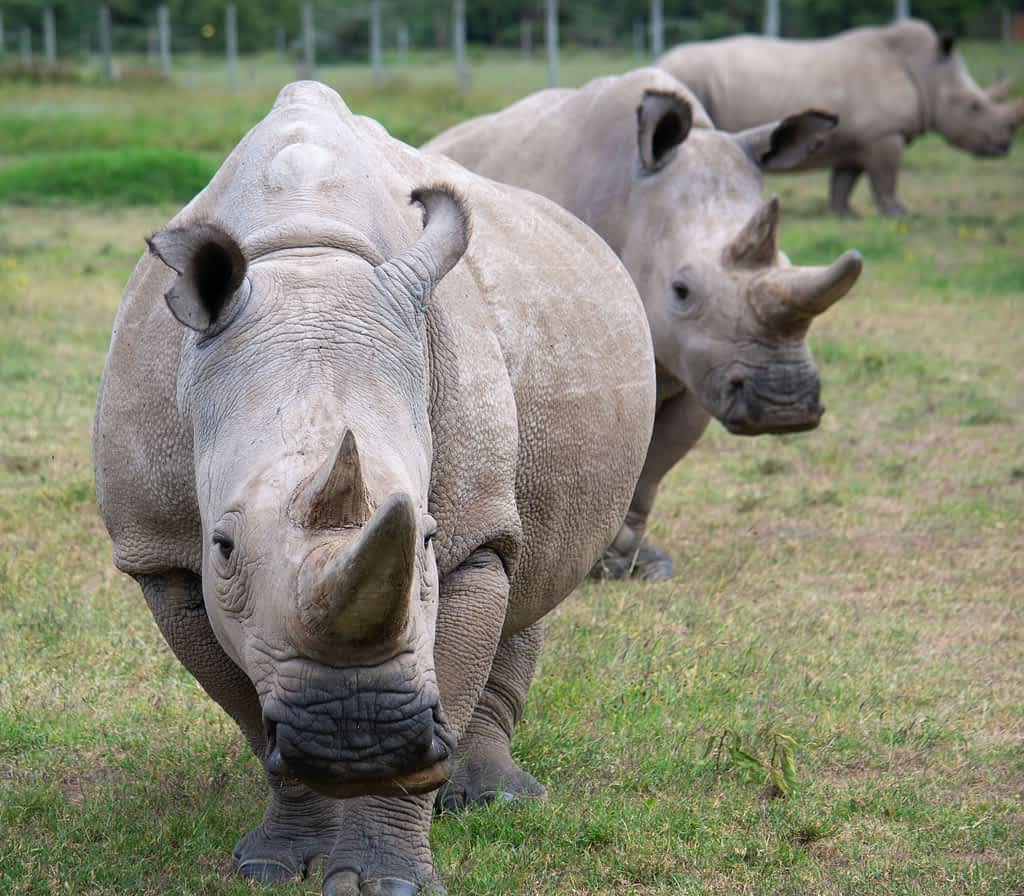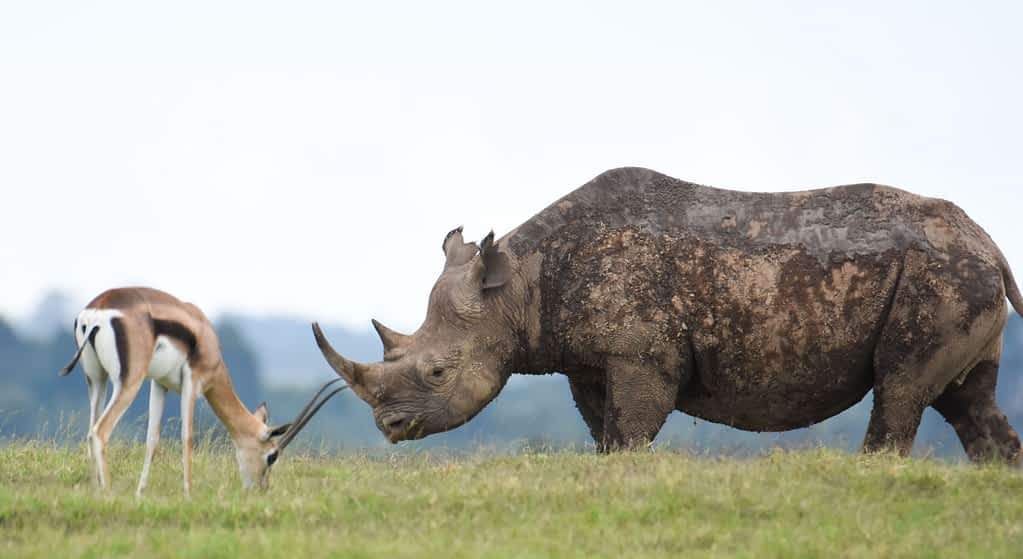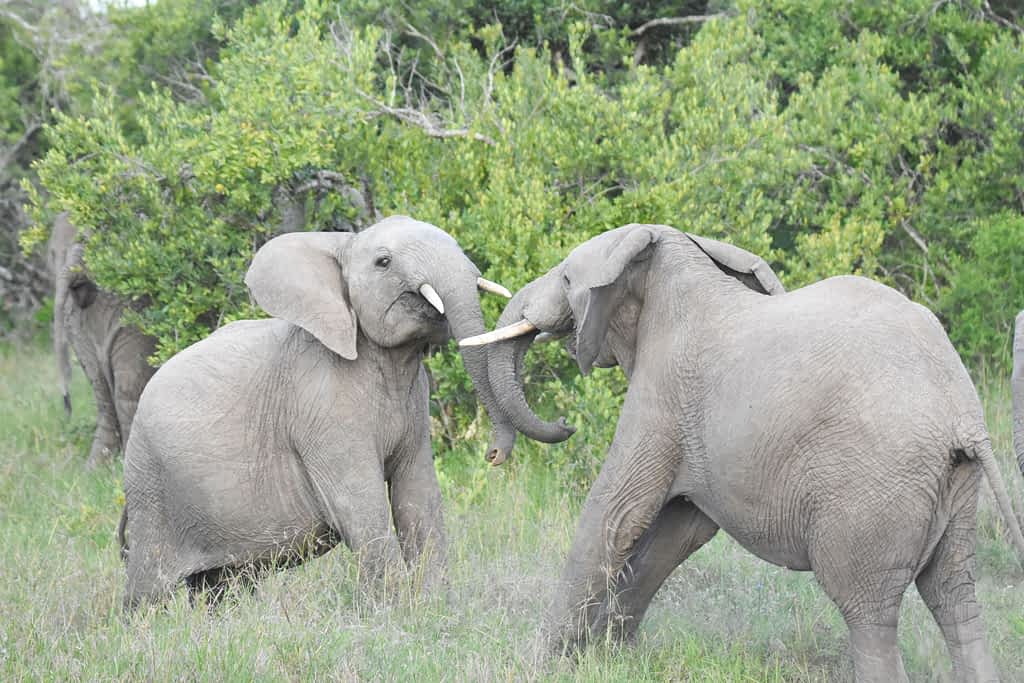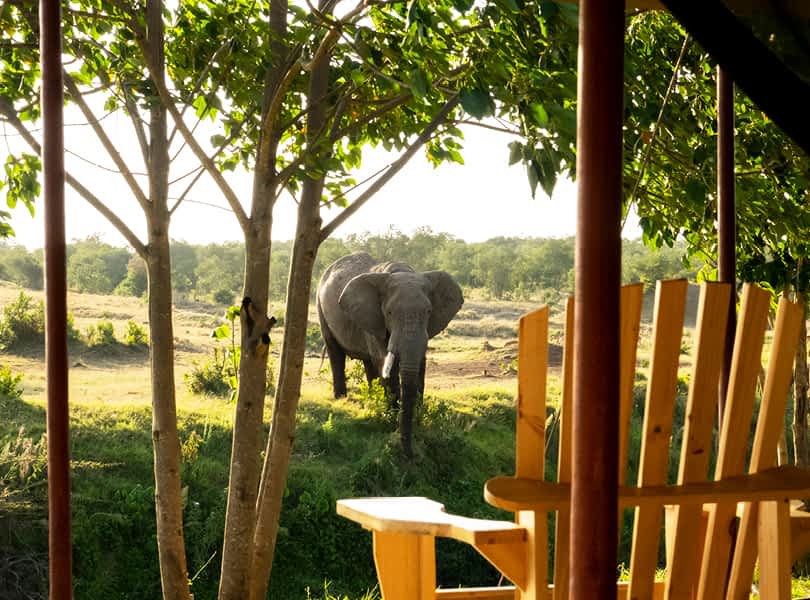While visiting Ol Pejeta Conservancy in Kenya, I had the chance to meet the last two remaining northern white rhinos in the world. It was a bittersweet experience. Seeing these amazing creatures was the opportunity of a lifetime, but it was difficult to think about the probability that their extinction was on the horizon. How did we get so far that this species was hanging on by a thread? I had to meet them and learn about what’s being done to save the species.

The Last of the Northern White Rhinos
Their story begins with Sudan, a male northern white rhino born in Shambe, Southern Sudan, in 1973. At two years old, he was taken to Dvůr Králové Zoo in the Czech Republic. There he fathered Najin, a female, in 1989. Najin’s older brother Suni was born in 1980. The pair were half-siblings who shared the same mother, but different fathers. In 2000, Fatu, Suni’s half-sister, was born and shared a father with Suni.
In 2009, Sudan, Najin, Suni, and Fatu were relocated to Ol Prejeta Conservancy. Sadly, Suni died in 2014 followed by Sudan in 2018. The death of Sudan was a major blow to the species as he was the last male northern white rhino in the world.
Today, Najin and Fatu are under constant protection at Ol Pejeta Conservancy. They are watched around the clock by armed guards. The Conservancy also keeps a veterinary team on standby in the event that something should happen to them or they need immediate care.

Visiting Ol Pejeta Conservancy
Ol Pejeta Conservancy is located 3.5 hours by car from the chaotic hustle and bustle of the Kenyan capital city of Nairobi. In addition to being home to the last remaining northern white rhinos, it also serves as a sanctuary for the critically endangered black rhino, southern white rhino, and chimpanzees.
Fun Fact – There are five species of rhinoceroses in the world – Sumatran, White, Black, Javan, and the Greater One-Horned rhino. Northern white rhinos and southern white rhinos are both subspecies of the white rhino.
I sat down with Samuel Mutisya, Head of Conservation at Ol Pejeta Conservancy, who explained that Ol Pejeta was taking the lead in rhino conservation. According to Mutisya, “the rhinos were brought to Ol Pejeta on the basis that it was an ideal place with expertise and the necessary infrastructure to recover the species”.
Ol Pejeta Conservancy is a part of the greater Samburu ecosystem. Many species migrate in and out of Ol Pejeta throughout the year. The only exception is the northern white rhinos. They are not permitted to leave since their security can only be guaranteed within the boundaries of Ol Pejeta.
Mutisya explained that “we have various programs running such as an ecological monitoring team whose research and findings are important to the preservation of the species, monitoring of the habitat, and tracking which species the habitat supports”.

The Dire Risk of Poaching to Rhino Populations
To save the species, it is critical to understand what threats are endangering the northern white rhino’s existence. Mutisya expressed how dire the situation has become across the continent due to poaching.
“They say that in the 60s and 70s we had more than 65,000 black rhinos on the continent. In Kenya alone, the population was 20,000 strong. In less than three decades that population crashed by almost 98% to less than 400 of the animals in Kenya. It was very catastrophic. But in the early 90s, conservation of this iconic species became important to the country”, explained Mutisya.
As conservation of rhinos became a focus, the population at Ol Pejeta Conservancy surged. “Ol Pejeta went from having 20 black rhinos to currently having over 115. We are now the largest black rhino sanctuary in East Africa — a place where conservation really takes center stage”, Mutisya boasted.
Despite these accomplishments, recovery of the species has been tough due to continued poaching. “Some years back, we had a very serious poaching threat. 2011 to 2013 were terrible. We lost five to six rhinos each year”, lamented Mutisya, “Management had to reinvent to the point where that number has been brought down to one rhino a year. Now, for the last three years, there has been no poaching here because of our dedicated teams committed to conserving and protecting the species, as well as government support and other donors”.
While optimistic, Mutisya cautioned that poaching is still an issue and stated that, “there were cases of poaching last year at another sanctuary, so the threat is still there. It shows that the effort we put in has improved the situation at the local and national levels”.
Why are Rhinos Poached?
Rhinos are poached for their horns which are thought to have medicinal purposes in traditional Chinese and Vietnamese medicine. Despite these claims, there is no scientific evidence that rhino horns provide any medical benefit. In fact, the horns are made of a protein called keratin. Keratin is the building block of hair and fingernails. Technically speaking, rhino horns are no different from human fingernails.
Even though the sale of rhino horns is banned by the Convention of International Trade in Endangered Species (CITES), they continue to be in high demand. Poachers are still willing to risk incarceration to fetch the high prices. Rhino horns sell for approximately $65,000 per kilogram on the black market making them more valuable than gold.
Tactics to Protect Rhinos
Poaching is a difficult problem to address because there are many people involved. Mutisya explained that “poaching is not a one-man show, it involves multi-layer teams. You have the main person orchestrating the whole thing with locals and semi-locals doing the actual poaching”.
Unfortunately, some poaching is done out of desperation and must rely on the local community to help intervene. “Sometimes the poacher is poor and paid in advance to keep trying. It is through our community engagement and commitment that help stop the poaching attempt. You have people planning something and you will hear about it from others in the community”, Mutisya explained.
Dogs play an important role in helping to track down poachers. “We have some attempts at poaching, and we must work backward. We use sniffing dogs to find out where these people are from, that’s if they came in and out of the Conservancy on foot”, stated Mutisya.
Apprehended poachers are tried in court. Under Kenyan law, people are innocent until proven guilty. Because of the money involved in poaching, many of these people are bailed out of jail by the poaching middlemen in an attempt to protect themselves. This makes the case take longer. To make matters worse, there is also corruption with high-ranking government officials. This is a problem that the Kenyan government must actively work to solve.
The Future of Northern White Rhinos
The only hope for the future of the northern white rhino is reproduction. Since neither Najin nor Fatu are able to carry a pregnancy, their fate rests in the hands of artificial reproduction techniques.
Scientists have made great strides in the process. In 2019, a team of veterinarians successfully harvested eggs from Najin and Fatu — a procedure that had never been attempted before with northern white rhinos. The eggs will need to be fertilized with frozen sperm from a northern white rhino bull. Once complete, the embryo will be transferred to a southern white rhino surrogate mother.
Meeting Najin and Fatu
During my visit, I was able to meet Najin and Fatu. Because of the COVID-19 pandemic, international tourism was down, and I was fortunate to get a private visit. The experience of being in the presence of these two magnificent animals and knowing they were the only two left on the planet was surreal.
In addition to seeing Najin and Fatu, I also visited Baraka, a blind black rhino who lives in an enclosure at Ol Pejeta Conservancy. Baraka was born in the wild but lost his sight. One eye was damaged during a fight and the other from a cataract. Baraka must be kept in the enclosure for his own safety. He is popular with visitors and loves to eat sugar cane from them. Baraka plays an important role as a rhino ambassador for the Conservancy.
Fun Fact – Despite their names, white and black rhinos are both gray in color. The easiest way to tell them apart is the shape of their upper lip. Black rhinos have a pointed upper lip while white rhinos have a square upper lip.

You can help by donating
Visiting Ol Pejeta Conservancy.
We hope that you get the opportunity to see these amazing rhinos yourself and the other wildlife at Ol Pejeta. If you are looking to visit, you can book a tour through a reputable tour agency like King Salama Safaris.



















